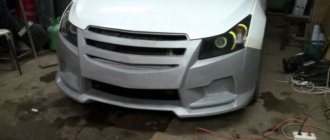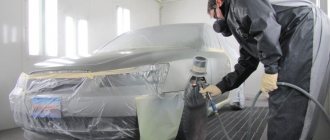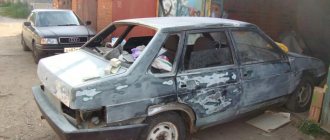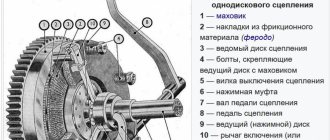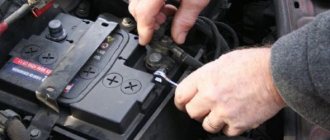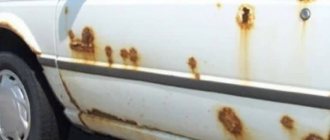Comments: no Published: 07/07/2017
Rating:
A car is a technically complex device consisting of a large number of parts, assemblies and mechanisms. Every self-respecting car owner is obliged to understand them, not even in order to be able to independently fix any malfunction that may arise on the road, but simply to understand the principle of operation of his car, and the ability to explain the essence of the problems that have arisen in a language understandable to a specialist. To do this, you need to know at least the basics, what main parts the car consists of, and what each part is called correctly.
See also:
Car muffler device
Car body
The basis of any car is its body, which is the body of the car that houses the driver, passengers and cargo. It is in the body that all other elements of the car are located. One of its main purposes is to protect the people and cargo in it from the influence of the external environment.
The supporting system of the car. It is the skeleton of the car, to which all the parts are subsequently attached.
Usually the body is attached to the frame, but there are also cars with a frameless design, and then the body simultaneously performs the functions of the frame. The car body structure is:
- single-volume, when the engine, passenger and cargo compartments are located in one volume (an example would be minivans or vans);
- two-volume, in which the engine compartment is provided, and places for passengers and cargo are combined in one volume (station wagons, hatchbacks, crossovers and SUVs);
- three-volume, where there are separate compartments for each part of the car body - cargo, passenger and engine (pick-ups, sedans and coupes).
Depending on the nature of the load, the body can have three types:
- carrier;
- semi-supporting;
- unloaded.
By the way, we would like to remind you that for cars and not only you can inexpensively buy interesting things on Aliexpress.
Most modern passenger cars have a supporting structure that absorbs all the loads acting on the car. The general structure of a passenger car body includes the following basic elements:
- spars, which are load-bearing beams in the form of a rectangular profile pipe, they are front, rear and roof spars;
Body load-bearing system. This system allows you to reduce the weight of the vehicle, lower the center of gravity, and therefore increase driving stability.
- pillars - structural elements that support the roof (front, rear and middle);
- beams and cross members, which are located at the roof, side members, under the engine mounts, and each row of seats, there is also a front cross member and a radiator cross member;
- thresholds and floors;
- wheel arches.
See also:
Car spar
Body layout
The load-bearing part of the car can consist of a frame and body, only the body, or be combined. The body that acts as a load-bearing part is called a load-bearing body. This type is most common on modern cars.
Also, the body can be made in three volumes:
- single-volume;
- two-volume;
- three-volume.
The single-volume one is made as a one-piece body that combines the engine compartment, passenger compartment and luggage compartment. This arrangement corresponds to passenger (buses, minibuses) and utility vehicles.
Double-volume has two zones of space. The passenger compartment, combined with the trunk, and the engine compartment. This layout includes hatchback, station wagon and crossover.
The three-volume one consists of three compartments: the passenger compartment, the engine compartment and the luggage compartment. This is a classic layout that sedans follow.
The different layouts can be seen in the figure below, and read in more detail in our article on body types.
Body layout
Car engine, its types
The heart of the car, its main component, is the engine. It is this part of the car that creates torque, which is transmitted to the wheels, causing the car to move in space. Today there are the following main types of car engines:
- ICE or internal combustion engine, which uses the energy of the fuel burned in its cylinders to produce mechanical energy;
- an electric motor powered by electrical energy from batteries or hydrogen cells (cars powered by hydrogen cells today are already available from most leading automakers as prototypes and are even in small-scale production);
- hybrid engines that combine an electric motor and an internal combustion engine in one unit, the connecting link between which is a generator.
It is a complex of mechanisms that convert the thermal energy of the fuel burning in its cylinders into mechanical energy.
By type of fuel burned, all internal combustion engines are divided into the following types:
- gasoline;
- diesel;
- gas;
- hydrogen, in which the fuel is liquid hydrogen (installed only on experimental models).
According to the design of internal combustion engines there are:
- piston;
- rotary piston;
- gas turbine.
See also:
Car vibrations: signs, causes and solution to the problem
Body type - a necessary element of car classification, which allows you to learn about the purpose and characteristics of a vehicle by its appearance.The shapes and varieties of bodies have evolved along with the mechanical part of the car, constantly becoming more complex. Accordingly, new body types appeared, and some became outdated and lost relevance. In many ways, the body type was determined by the functional parameters of the car and depended on what its main purpose was in a given period of history. Thus, at the dawn of the automobile industry, only very rich people could afford self-propelled carriages, who used them mainly for entertainment. This explained the primitive shape of the body, like a carriage, intended for walking in good weather. Over time, cars became more comfortable and multifunctional, and their bodies became more diverse.
The traditional set of basic body styles (coupe, sedan, station wagon, convertible, pickup) was formed after the Second World War, and the hatchback body became widespread only in the 70s. At the present stage of car development, there is a tendency for new body types to appear, combining the advantages of two classic ones. For example, a targa is a transitional type between a coupe and a convertible, and a sportback is a cross between a sedan and a hatchback.
The body type of a car largely depends on its class and price segment. Nowadays, compact models most often have a hatchback body, mid-range models are offered as sedans, hatchbacks and station wagons, executive cars are equipped with sedan and limousine bodies, and sports cars are sold as coupes, convertibles and roadsters. Since practicality often conflicts with the design and other characteristics of the car, budget models become more versatile and multifunctional, while higher-end cars retain their individuality and clearly defined scope of application.
Based on the criterion of the presence or absence of a roof, bodies are divided into open and closed, although in some cases (landaulet, coupe de ville) the car is neither one nor the other. Based on the number of clearly expressed geometric shapes into which the silhouette of the car is divided, it is customary to distinguish single-volume (the hood looks like one with the rest of the body), two-volume (separate hood and interior) and three-volume (separate hood, interior and trunk) bodies.
| Two door | Amer. Sedan, English Saloon, French Berline, Italian Berlina, German Limousine is a closed 2- or 4-door three-volume body with a trunk separated from the passenger compartment. Has two or three rows of seats and four or six side windows. In addition to traditional notchback sedans, we also include in this category 4-door fastbacks, 4-door sedans with a trunk lid that opens with the rear window (liftbacks), classic sedans with a vertical rear wall and an attached trunk, and long 7-seater cars. without a partition in the cabin and modern “four-door coupes”. | ||
| Four-door | |||
| Coupe | Single | Coupe is a two-door closed three-volume body with one or two rows of seats and a trunk separated from the passenger compartment. The compartment is designed for two passengers, but can have additional seats for children or short-term accommodation for adults (2+2). The four-seat coupe has two full rear seats, but differs from the 2-door sedan by a lower roof and a small or no second pair of side windows. In a three-seater coupe, the driver's seat is located in the front center, and the passenger seats are located a little further on the sides of it. | |
| Double | |||
| Triple | |||
| 2+2 | |||
| Quadruple | |||
| Hardtop | Coupe | Hardtop is a car with a hard top without central roof pillars and fixed side window frames. The only difference between the hardtop and other body types is the fully opening side windows. There are 2-door hardtop coupes, 4-door hardtop sedans and 5-door hardtop station wagons. Most hardtops were produced in the USA in the 50s - 70s. Hardtops do not include their imitations (Pillared Hardtop or Colonnade Hardtop) and convertibles with a folding or removable hardtop. | |
| Sedan | |||
| Station wagon | |||
| Cabriolet | Double | European Cabriolet, American Convertible, English Drophead Coupe is an open three-volume body with a soft or retractable hard top. Convertibles can be either two-seater (including one additional transverse seat), or four-seater (including with folding seats outside the cabin, as well as a 2+2 configuration). In addition, there are four-door convertibles, which differ from phaetons by the presence of side windows. Some post-war convertibles had a soft center roof and fixed metal side window frames, while modern convertibles have an automatic roof folding mechanism. | |
| Quadruple | |||
| Four-door | |||
| Roadster | Single | Roadster (Spyder) is an open two-seater, two-door, three-volume body with a folding or removable soft or hard roof. Among racing cars you can find single-seat roadsters, and among pre-war models there are roadsters with an additional folding seat outside the cabin (rumble seat). A type of roadster is the speedster (Speedster, Italian: Barchetta) - a two-seater car without a roof and side windows, and sometimes without a windshield. | |
| Double | |||
| Phaeton | Two door | Phaeton, Torpedo, English. Tourer is an open body with a retractable soft top without roll-up side windows. As a rule, phaetons were four-door, although there were also two-door ones, and early phaetons had no doors at all. This body type differed from the four-door convertible by the complete absence of side windows or their replacement with fastened canvas curtains with celluloid windows. Some phaetons were equipped with a partition between the front and rear seats (dual cowl phaeton). Most phaetons disappeared after World War II. | |
| Four-door | |||
| Station wagon | Three-door | Station Wagon, Estate Wagon, German. Kombi is a closed two-volume body with a rear loading door and a large luggage compartment combined with the interior. Has three or five doors and two or three rows of seats. The rear door can lift up, open to the side or be double-leaf. Three-door station wagons include a special type of Shooting Brake body, common among British aristocrats and intended for hunting trips. Most SUV class cars are equipped with a station wagon body. | |
| Five-door | |||
| Hatchback | Three-door | Hatchback is a closed two-volume four-seater body with a door in the rear wall and a small trunk. It differs from the station wagon in its more compact dimensions and shorter rear overhang. It can be either three- or five-door. The hatchback body is common among compact cars and crossovers. | |
| Five-door | |||
| Sportback | Sportback is a closed two-volume four-door body with a sloping roof and a trunk lid that opens with the rear window. Essentially a variation of the liftback, but with a sporty fastback-style roof shape, without a protruding trunk. The term Sportback belongs to Audi, but there are also models from other brands with this body style. | ||
| Fastback | Fastback is a closed two-volume two-door body with a sloping roof that smoothly turns into the trunk lid and a fixed rear window. Traditionally, aerodynamic 4-door sedans and 2-seat coupes were also considered fastbacks, but we only include 2-door cars with a 2+2 seating arrangement. | ||
| Targa | Targa is an open three-volume two-door body with a metal roll bar behind the seats and a fixed rear window. A type of roadster or convertible, it can have 2 or 4 seats. As a rule, it is equipped with a removable soft or hard roof. Targs include American coupes with a T-roof with removable side panels, but do not include rear-engined roadsters with a fixed rear window. | ||
| Limousine | Limousine is a closed three-volume body with a glass partition in the cabin separating the front row of seats from the passenger part. Most limousines also differ from sedans by having a longer wheelbase, three or more rows of seats, and an additional pair of side windows. | ||
| Landaulet | Landau is a type of limousine with an opening rear roof over the passenger section. Can be equipped with either a soft top or a transparent canopy. | ||
| Brogem sedan | Brougham Sedan, European. Coupe de Ville, American Town Car, English Sedanca de Ville is a four-door body with a removable part of the roof above the front row of seats and a closed passenger compartment and a glass partition between the sections. A type of limousine, common in the pre-war years. | ||
| Brogem coupe | Brougham Coupe The Sedanca Coupe is a two-door, four-seater body with a retractable soft or hard roof over the front seats and fixed rear pillars and rear window. Pre-war variety of convertible; a modern analogue is targa. | ||
| Minivan | Minivan, MPV - a closed single-volume body with increased capacity. It usually has a cabover or semi-hood layout, a high roofline and one side passenger door that slides along the body. Traditional minivans have no more than nine seats, but this category also includes small minibuses like the Volkswagen T1. | ||
| SUV | All-road vehicle, Off-roader - an all-wheel drive off-road vehicle capable of driving off-road. As a body type, an SUV is an open or closed 2- or 4-door utilitarian all-terrain vehicle, designed for use in difficult conditions. | ||
| Pickup | A light truck with a 2- or 4-door closed cab and an open cargo area at the rear. It can be built on the basis of a passenger car, truck or SUV. | ||
| Van | Panel Van is a closed body with a 2-door cab and an unglazed cargo compartment. There are two types of vans: a pickup truck with an enclosed cargo bed, and a station wagon or minivan with metal panels instead of rear windows. | ||
| Microcar | A hybrid of a car and a motorcycle with an open or closed body of uncertain shape. Microcars come with 3 or 4 wheels and can accommodate from 1 to 4 people. Some of them have one front door, while others enter the cabin through an opening transparent hood. Microcars also include Soviet wheelchairs. | ||
| Motorized stroller | Motorized carrriage, horseless carriage - a vintage car of the late 19th - early 20th centuries with a 2- or 4-seater open body without doors. It had a primitive design, reminiscent of a horse-drawn carriage. 2-seater motorized strollers without doors and a windshield were called Runabout, 4-seater strollers were called Tonneau. | ||
Transmission
The main purpose of the transmission is to transfer torque from the engine crankshaft to the wheels. The elements of which it consists have the following names:
- A clutch, which is two friction discs pressed against each other, which connect the engine crankshaft to the gearbox shaft. This connection of the shafts of the two mechanisms is made detachable so that, by pressing the disks, it is possible to break the connection between the engine and the gearbox, to change gears and change the speed of rotation of the wheels.
This is a power transmission that connects the engine with the driving wheels of the car.
- Gearbox (or gearbox). This unit is used to change the speed and direction of movement of the car.
- A cardan transmission, which is a shaft with articulated joints at the ends, serves to transmit torque to the rear drive wheels. It is used only in rear-wheel drive and all-wheel drive vehicles.
- The main gear located on the drive axle of the vehicle. It transmits torque from the driveshaft to the axle shafts, changing the direction of rotation by 90°.
- A differential is a mechanism that serves to provide different rotation speeds of the right and left drive wheels when the car turns.
- Drive shafts or axle shafts are elements that transmit rotation to the wheels.
All-wheel drive vehicles have a transfer case that distributes rotation to both axles.
See also:
How does a car's air suspension work?
Bus body
It is usually made closed; most often it is made of a load-bearing, “carriage” type frame structure. A metal cladding is attached to the frame from the outside and inside. (less often from composite materials) panels.
Trends in the development of automobiles: reducing weight (including through the use of new materials), giving a streamlined shape, increasing convenience for passengers, improving the use of vehicle dimensions, etc.
Chassis
The complex of mechanisms and parts that serve to move the car and dampen the resulting vibrations and vibrations is called the chassis. The chassis includes:
- the frame to which all other elements of the chassis are attached (in frameless cars, elements of the car body are used to attach them);
The chassis is a set of devices that interact with each other to move the vehicle along the road.
- wheels consisting of disks and tires;
- front and rear suspension, which serves to dampen vibrations that occur during movement, and can be spring, pneumatic, spring or torsion, depending on the damping elements used;
- axle beams that serve to install axle shafts and differentials; they are only available in cars with dependent suspension.
Most modern passenger cars have independent suspension and do not have axle beams.
Rigidity
Rigidity is the property of a car body to resist dynamic and static loads during operation. It directly affects handling.
The higher the stiffness, the better the car's handling.
Rigidity depends on the body type, overall geometry, number of doors, car size and windows. The fastening and position of the windshield and rear windows also plays an important role. They can increase stiffness by 20-40%. To further increase rigidity, various reinforcement struts are installed.
Hatchbacks, coupes and sedans are considered the most stable. Typically, this is a three-volume layout that has additional partitions between the luggage compartment and the engine. Insufficient rigidity is shown by station wagon, passenger, and minibus bodies.
There are two stiffness parameters - bending and torsion. For torsion, resistance is checked under pressure at opposite points relative to its longitudinal axis, for example, when hanging diagonally. As already mentioned, modern cars have a solid monocoque body. In such structures, rigidity is provided mainly by side members, transverse and longitudinal beams.
Steering
To move normally in a car, the driver needs to make turns, U-turns or detours, that is, deviate from straight-line movement, or simply control his car so that it does not drift to the side. For this purpose, its design provides steering control. This is one of the simplest mechanisms in a car. Let's look at the names of some of the elements below. The steering system consists of:
- steering wheel with steering column, this is the name of the ordinary shaft on which the steering wheel is rigidly mounted;
These devices consist of a steering system that is connected to the front wheels by steering and brakes.
- steering mechanism, consisting of a rack and pinion mounted on the steering column shaft, it converts the rotational movement of the steering wheel into translational movement of the rack in the horizontal plane;
- steering gear, which transmits the influence from the steering rack to the wheels to turn them, and includes side rods, a pendulum lever and wheel turning arms.
Modern cars use an additional element - power steering, which allows the driver to use less force to turn the steering wheel. It comes in the following types:
- mechanical;
- pneumatic booster;
- hydraulic;
- electric;
- combined electric hydraulic booster.
See also:
Roof rails for Lada Kalina car
The metal part of the body consists of the following body parts:
- Underbody (treated with anti-corrosion materials to reduce corrosion);
- Body roof;
- Body wings (treated with anti-corrosion materials to reduce corrosion);
- Body panels;
- Body doors (attached to the body pillars with hinges, which are held in place by screws, with the help of which the doors are adjusted vertically and horizontally); The door locks have a special design that prevents the door from opening even in the event of an accident.
- Body hood;
- Trunk lid.
Bumpers are installed at the front and rear of the body. On modern cars, bumpers are made of plastic or other similar materials. In the event of an accident, the car's bumper is the first to take the impact.
To accommodate the driver and passengers, seats are installed inside the car. Car seats are installed on special slides that allow you to adjust the seat in the longitudinal direction. You can also adjust the seat tilt, which is provided by special handles on the sides of the seats. The seat tilt can be adjusted until the bed is installed.
Recently, cars with hatchback and station wagon body styles have become very popular. This popularity is explained by the ability to transform the car into both a cargo and passenger version.
Brake system
An important part of the machine that ensures safe driving is the braking system. Its main purpose is to forcefully stop a moving vehicle. It is also used when it is necessary to sharply reduce the speed of the car.
There are three options for the braking system: service, parking, spare.
The brake system comes in the following types according to the type of drive:
- mechanical;
- hydraulic;
- pneumatic;
- combined.
Modern passenger cars are equipped with a hydraulic brake system, which consists of the following elements:
- brake pedals;
- main hydraulic cylinder of the brake system;
- master cylinder filling tank for filling brake fluid;
- vacuum booster, not available in all models;
- front and rear brake piping systems;
- wheel brake cylinders;
- brake pads pressed by wheel cylinders to the wheel rim when braking a vehicle.
Brake pads are either disc or drum and have a return spring that presses them away from the wheel rim when the braking process is complete.
Electrical equipment, which is a set of electrical devices and devices that ensure normal engine operation
See also:
Car body types
Aluminum body
Modern designers are constantly looking for ways to reduce weight without losing rigidity and strength. One of the promising materials is aluminum. The mass of aluminum parts in European cars in 2005 was 130 kg.
Nowadays aluminum foam material is actively used. This is a very light and at the same time rigid material that absorbs impact well in a collision. The foam structure provides high heat resistance and noise insulation. The disadvantage of this material is its high cost, about 20% more expensive than traditional analogues. Aluminum alloys are widely used by the Audi and Mercedes concerns. For example, due to such alloys it was possible to significantly reduce the weight of the Audi A8 body. It is only 810 kg.
Aluminum body of Audi A8
In addition to aluminum, plastic materials are being considered. For example, the innovative alloy “Fibropur”, which is almost as hard as steel sheets.
The body is one of the most important structural components of any car. The weight, controllability and safety of the vehicle largely depend on it. The quality and thickness of materials affects durability and corrosion resistance. Modern automakers are increasingly using carbon fiber or aluminum to reduce the weight of the structure. The main thing is that the body can provide the greatest possible safety for passengers and the driver in the event of a collision.
Electrical equipment
One of the most complex systems of passenger cars with many different elements and wires connecting them, entangling the entire car body, is electrical equipment, which serves to provide electricity to all electrical devices and electronic systems. Electrical equipment includes the following devices and systems:
- battery;
- generator;
- ignition system;
- light optics and interior lighting system;
- drives for electric motors of fans, windshield wipers, window lifts and other devices;
- heated windows and interior;
- all electronics of the automatic transmission, on-board computer and protective systems (ABS, SRS), engine management and others;
- power steering;
- anti-theft alarm;
- sound signal.
This is an incomplete list of devices included in the electrical equipment of a car and consuming electricity.
Every driver needs to know the structure of the car body and all its components in order to always maintain the car in good condition.
Basin (trunk floor)
In some cars, this container actually collects water, especially during the rainy season. It’s unlikely that you’ll be able to wash yourself in one, but it’s easy to spread corrosion. I think there is no need to explain where this element is located. Let me just show you a photo and you will understand everything:
The notorious "basin". Photo from Yandex.Pictures
Separate from the car - there really is a similarity, isn't it?)
After reading this article, you have reinforced your knowledge, and maybe learned something new for yourself.
Be sure to subscribe to us, like us and answer the question in the comments: what do you want to know about in the next articles?
Don't forget to fasten your seat belt. Taking care of your safety, DNA-AUTO.
See you in the next articles!
- Previous: Legal check of a car: what is it and how to check it yourself?
- Next: 2022 Hummer, better than the Cybertruck? -Yes
Elements of the body structure of the GAZ-3102 Volga car:
1 — front door hinge; 2 — bolt securing the hinge to the body; 3 — bolt securing the hinge to the door; 4 - limiter; 5 - arc; 6 - rubber bushing.
The body structure of a passenger car is a spatial system consisting of stamped panels and box-section frame elements connected to each other by spot welding. Panels with cross members form a base (floor), limited on the sides by thresholds (longitudinal beams). The sides of the body, forming parts of the sills and pillars, go into the rear wings. The top of the body is limited by the roof panel. The box rods that limit the sides of the front (wind) window are called wind window pillars, the vertical box rods between the front and rear doors are called central pillars. All body parts are made by stamping from low-carbon, thin-sheet steel (0.7-0.9 mm thick), heavily loaded parts are made from sheets 1.2 mm thick. Some parts, especially those that are susceptible to corrosion, are made from sheet metal coated with a zinc-based coating.
Classification of body types
Over the past two decades, the automotive industry has achieved a significant breakthrough in the field of design and technical equipment of cars. In the modern automotive industry, the classification of body types is based on the following parameters: shape, purpose, layout, functionality, degree of load. Passenger vehicles traditionally have cargo-passenger and passenger body frame types of semi-frame and frameless construction.
Body frames are distinguished by the location of passengers, cargo, power unit, and the degree to which they can support the weight of cargo and passengers. So, the machine can have three, two, one compartments. All body styles have standard names used throughout the world, but some countries produce separate body types with a different name.
Truck bodies
Truck bodies are platforms or containers of a specific configuration used to accommodate and transport goods. They are divided into closed and open. The flatbed, dump body has an open type of construction, the van, tank, awning has a closed type.
The following options are available on the Russian equipment market: tilt semi-trailer (transportation of large dimensions up to 25 tons), refrigerator (transportation of food, medicine), isothermal van (delivery of food and non-food products), container ship (transportation of containers). Flatbed semi-trailers, platforms, car transporters, trawls and timber carriers are also in demand. The designs are distinguished by variability in load capacity, loading methods, and temperature conditions.
Body type SUV
The SUV body type is a two-volume closed body structure with 5-6 doors, 2-3 rows of passenger seats. The car is taller than a station wagon, larger than a crossover. The vehicle is distinguished by large dimensions, all-wheel drive, low-range gearing, and increased ground clearance (at least 200 mm) for off-road maneuverability. Many manufacturers produce SUV models with a short wheelbase, three doors, shortening the niche in the coupe.
The car is considered universal due to its high, appropriate technical characteristics. Similar to some pickup trucks, vans have a frame unloaded body. Modern SUVs are conventionally divided by size: compact, mid-size, full-size.

